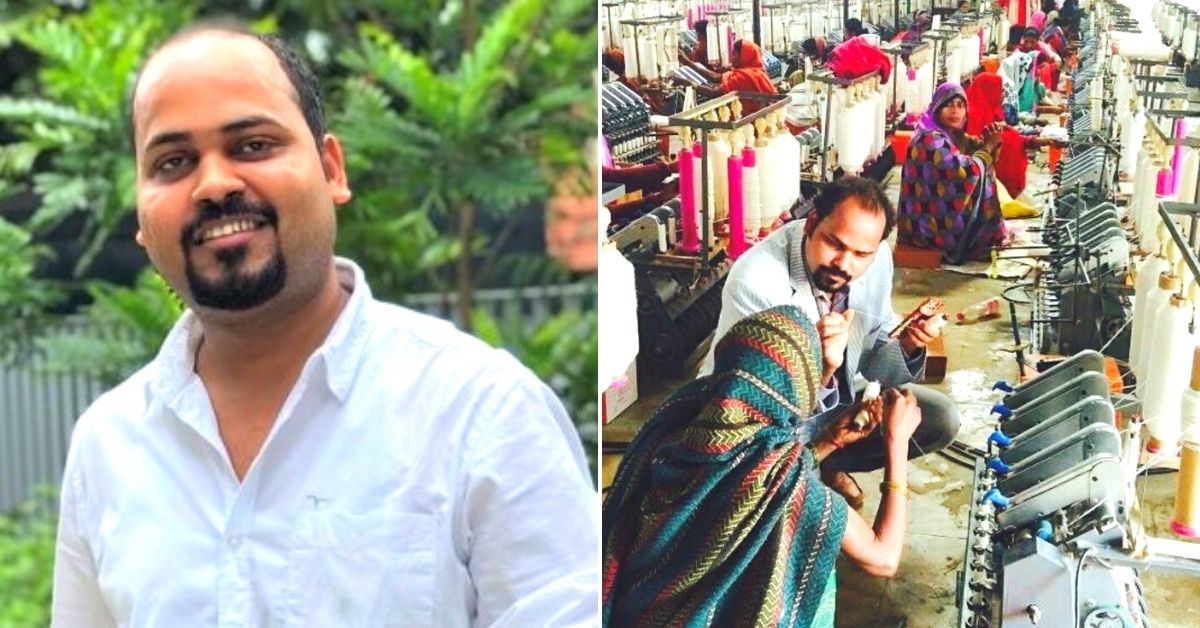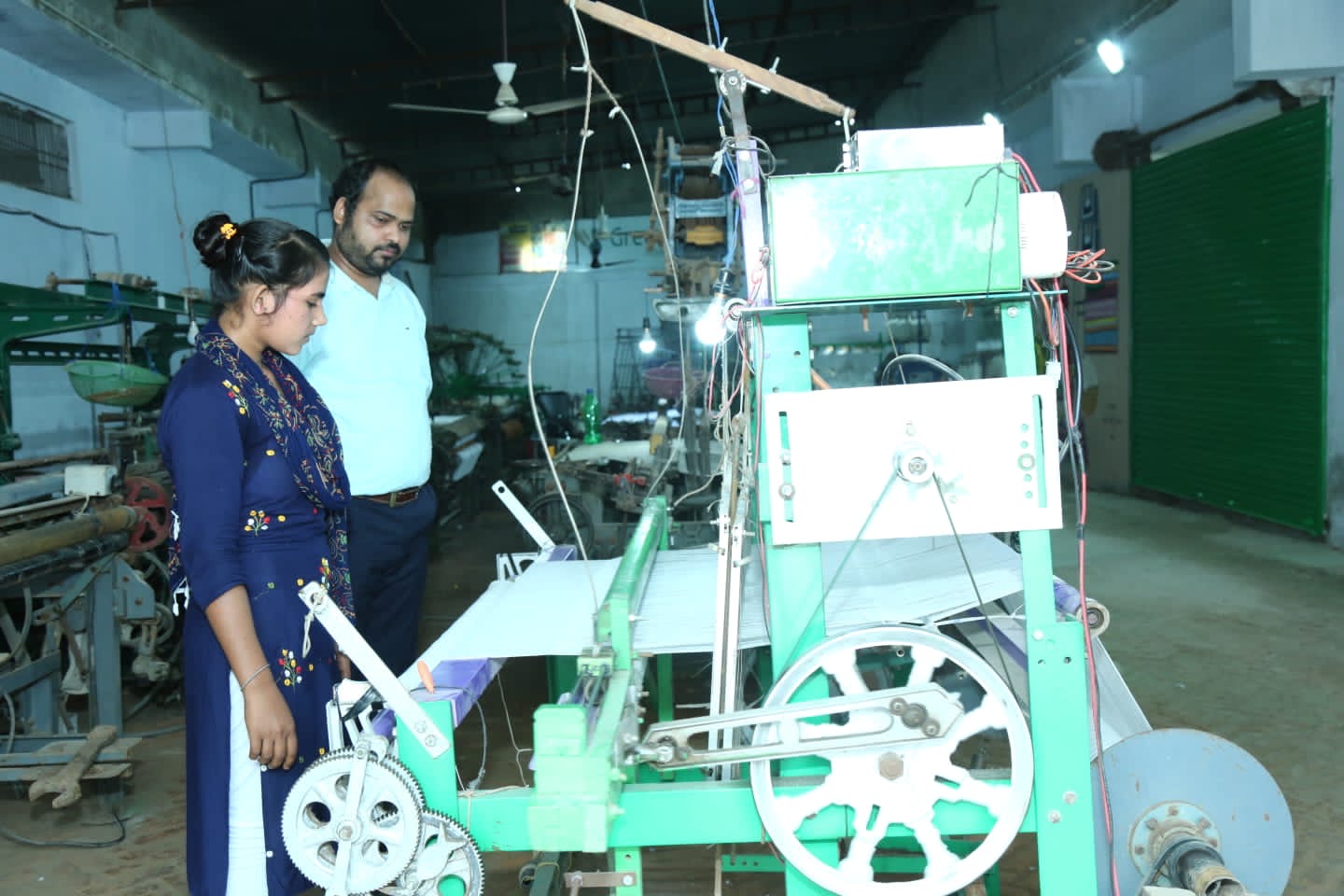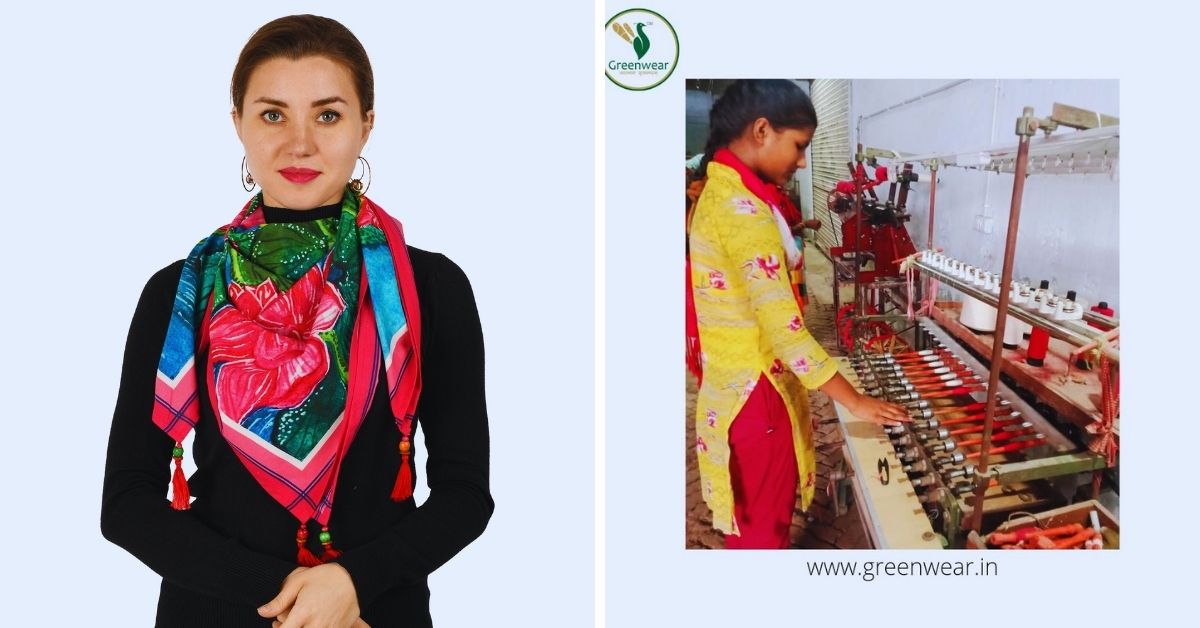NIFT Grad Designs Innovative Clothes Using Solar Energy, Empowers Over 500 Women
Lucknow-based Greenwear Fashion, founded by Abhishek Pathak, produces a variety of fabrics, including Khadi, woven on solar looms and handlooms, and also creates different types of garments using these fabrics.

Do you know of a ‘sustainable fashion brand’ that spins its yarn on solar charkhas, weaves fabrics on solar looms and stitches garments on solar-powered sewing machines?
Founded in 2016 (but incorporated in 2019) by Abhishek Pathak, a graduate of the National Institute of Fashion Technology (NIFT) in Delhi, Greenwear Fashion Private Limited is powered by renewable energy to create “high-quality” yet affordable textiles and garments.
(Image above of Abhishek Pathak, Founder and CEO of Greenwear Fashion)
Greenwear’s USP lies in its internal value chain of ‘solar-vastra’, i.e. yarns spun on solar charkhas, fabrics woven on solar looms and garments stitched on solar sewing machines
Based out Lucknow, Greenwear also provides forward market linkages to solar charkha yarns homespun by rural women in different textile clusters of Uttar Pradesh and Bihar by producing a variety of fabrics, including Khadi (hand spun and woven natural fibre cloth) woven on solar looms and handlooms, and also creating different types of garments using these fabrics. While yarns are spun by rural women in their households (hence they are also called homespun), the fabrics are woven by traditional weavers or newly trained loom operators.
“Greenwear’s focus since its inception revolved around creating livelihood opportunities for rural women and reducing the fashion industry’s carbon footprint. It is working in close association with Bhartiya Harit Khadi Gramodaya Sansthan (BHKGS), which has trained around 3,500 rural women across the country in the skill of spinning yarns on solar charkhas. It provides training for three months and then facilitates these women by linking them with financial institutions so that they become owners of 10-spindle, solar-run charkha installed in their households. Hence, these women are able to work from their households while taking care of family and daily chores,” says Abhishek Pathak, Founder and CEO, speaking to The Better India.

Finding Inspiration
Born and raised in Sultanpur, Uttar Pradesh, Abhishek studied textile design at NIFT-Delhi.
“Studying in NIFT-Delhi gave me exposure to a plethora of fashion-related design and technology. There were also several field trips during this period that helped shape my ideas and understanding of fashion. Students from NIFT visited artisan clusters to learn about their local artwork. My first visit was to a weaving cluster called Maheshwar in Madhya Pradesh, where I witnessed weaver clusters at the grassroots,” he recalls.
Despite starting his professional career with a US-based home furnishing brand, Abhishek always knew that he wanted to start something of his own in Indian textiles. During his vacations, he would visit different artisan clusters to learn more about them. After working two years at the US venture in product development, he started his clothing brand called Prakritii with a friend. But within 6 months, he shut shop because he lacked “great business sense”.
However, while Prakriti was still functional, he wanted to use the scrap fabric to produce jewellery and was looking to get in touch with people who could help do that. That is when he discovered the Drishtee Foundation, a non-profit based out of Noida. He would join them and lead their textiles and crafts department, which gave him the opportunity of working with mostly female artisans in Assam, Bihar and UP, and exploring the textile value chain.
The turning point for Abhishek came at an Indian International Trade Fair at Pragati Maidan in 2016, where he saw a solar charkha designed by IIT-Delhi and the Mahatma Gandhi Institute for Rural Industrialization (MGIRI)-Wardha. He noticed that the machine was efficient, reduced drudgery and was powered by clean energy. After the event, he got in touch with the innovators and wanted to start a Khadi vertical at Drishtee to understand how these solar charkhas worked.
Gradually after pondering over this and speaking with sector experts, he was inspired to come up with a business model involving solar charkhas and employing several women (esp rural women) from across India. So, this was the beginning of Greenwear in 2016, although it was officially incorporated as a business in 2019. In late 2016, he joined the BHKGS, a government-sponsored non-profit, as its CEO where along with a team of 185 people they executed the pilot project for Mission Solar Charkha launched by the Union Ministry of MSME and trained more than 3,500 rural women on solar charkha spinning, he claims.
“My motivation to start Greenwear emanated from the willingness to change the textile production sector for producers and users. I found that after 8 hours of operating a manual charkha, a woman would earn just Rs 50 for the khadi fabric. With a solar charkha, a woman could earn four times more without having to spend as much time on the solar charkha. It is easy to operate and has no issues with power shortages. I was also mindful about going about the operations sustainably as I was also concerned about increasing pollution. I did not want to contribute to environmental degradation in any way,” notes Abhishek.

Going Solar
A solar charkha with 10-spindles capacity can produce 1 kg of cotton yarn in 8 hours. BHKGS provides raw material (Sliver) to these women and collects the finished goods (yarn) while paying Rs 200 per kg into their bank accounts. Hence, each woman is empowered to earn Rs 6,000/- per month. Since there is no drudgery in operating solar charkhas, one woman can easily run two machines simultaneously and earn upto Rs 12,000, he claims.
“Solar charkhas and solar looms are mostly established in the households of artisans. The most popular solar charkha model has 10 spindles with a capacity to produce 1 kg of yarn in 8 hours. It is attached with a 60w PMDC motor, which runs through a 12v battery and a charge controller powered by a 120w solar panel. The entire production chain runs on solar energy,” he explains.
Solar looms are categorised in three parts – specially made solar looms as per production requirements, power looms having power source as solar and modified pedal looms. Most looms are run through a 1kw AC motor which is then connected with a solar set. In some clusters where looms are established as sets of four or five, it is run on a solar grid of 5 kw. In Khanwa village, Bihar, there is one hybrid grid established, which has 4 kw solar energy and 1 kw wind energy. Garment manufacturing units are set up as centralised facilities in the interest of quality assurance and aggregation. These units are powered by solar grids having an energy generating capacity of 10 to 50 kw. Power consumption depends on the work orders they get.

“The yarn collected by BHKGS is purchased by Greenwear after thorough quality checks and further work orders get assigned based on market forecasts and requirements. Hereafter, Greenwear distributes these yarns to various traditional textile clusters in cities like Gaya, Bhagalpur, Varanasi and Bijnor to get converted into fabrics. Greenwear further encourages and facilitates existing powerloom weavers to run their looms on solar power and in turn ensures regular workflow for solar looms. These fabrics are then marketed by Greenwear to various mainstream fashion brands and to its own retail outlets,” explains Abhishek.
If we take example of shirting fabrics, 1 kg yarn is used to make around 8 meters of fabric and a solar loom can weave 24 meters fabric in 8 hours. Hence, three solar charkhas can feed one solar loom in the textile value chain. Further, weaving consists of five processes which engage manpower at each level. “Usually, the entire family of the weaver gets involved in various processes of converting solar yarns into solar vastra. For plain woven fabric the weaver earns Rs 25 per meter and can earn upto Rs 18,000 per month,” he adds.
At least 80% of fabric gets sold as unprocessed fabric to well-established brands. The rest of the fabrics are used for value addition techniques such as dyeing, printing and embroidery. Greenwear is also exploring organic dyeing techniques and traditional crafts on its fabrics. It has two stitching units in Nawada (Bihar) and Lucknow (UP) where 380 women artisans are engaged in garment construction processes.
The entire value addition process is running on solar and hybrid renewable energy resources and are directly impacting rural women artisans. So far, the venture has engaged more than 500 rural women in UP and Bihar, most of whom are working for the first time.
Greenwear is currently producing a variety of fabrics woven on solar-looms and hand-looms. Further it also creates garments using these fabrics. Their price range starts from Rs 500 and goes upto Rs 3000 based upon the content of products.
At present their major buyers are two leading womenswear brands in India– ‘W for Women’ and ‘Aurelia’. These brands not only procure fabrics from Greenwear, but they also provide work orders to the rural women artisans to stitch garments.

Working With Women, For Women
Of course, no venture like this can go on without addressing major challenges, particularly during the COVID-19 pandemic which saw demand for fabric come down significantly. Thankfully, assistance for Greenwear came from Powering Livelihoods, a Council on Energy, Environment and Water (CEEW) and Villgro initiative. For the uninformed, CEEW is a Delhi-based think tank, whereas Villgro is an incubator of social enterprises.
“The support from the Powering Livelihoods programme has been particularly helpful because their engagement began just before the pandemic. Powering Livelihoods (PL) is a CEEW-Villgro initiative that aims to boost India’s rural economy by scaling up the penetration of clean energy-powered appliances for livelihoods. We are one of the enterprises that the initiative supports. In addition to providing Greenwear with financial assistance, sustained and continuous association with PL has served very well. Under the programme, we have received important inputs to streamline our business model, explore more efficient processes in running our business, testing new products, market planning etc,” claims Abhishek.

Meanwhile, it was back in 2019, when their first round of funding came from the IIM Calcutta Innovation Part in 2019 with a seed funding of Rs 50 Lakh. Greenwear also got the opportunity to become a part of their startup incubation programme. Additionally, they received foreign direct investment (FDI) from Upaya Social Ventures, who are Seattle based impact investors.
In the past two financial years, the venture claims to have obtained a revenue of about Rs 2 crore.
Currently Greenwear has two retail showrooms in Lucknow and they are in the process of establishing their own ecommerce store. Greenwear has also partnered with Amazon Karigar and Flipkart Samarth initiatives and will be available on their ecommerce platforms from December 2021 onwards.
Greenwear operates via both the B2B and B2C business models. They have also obtained a few institutional buyers, including hospitals, schools and corporate offices for their uniforms and other textile related requirements.

“In the near future, Greenwear aspires to penetrate into new market segments to expand its collection and introduce segments such as Maternity-wear, Yoga-wear, Lounge-wear, Kids-wear, Hospital-wear and Hospitality-wear. In terms of product, Greenwear strives to have zero defects in quality and zero harmful effects on the environment given how the textile industry pumps between 1.22 and 2.93 billion metric tonnes of carbon dioxide into the atmosphere every year. More importantly, however, our primary mission is to create better livelihood opportunities for at least 5,000 rural women through solar charkha-based spinning and allied activities,” he says.
(Edited by Yoshita Rao)
Like this story? Or have something to share? Write to us: [email protected], or connect with us on Facebook and Twitter.
If you found our stories insightful, informative, or even just enjoyable, we invite you to consider making a voluntary payment to support the work we do at The Better India. Your contribution helps us continue producing quality content that educates, inspires, and drives positive change.
Choose one of the payment options below for your contribution-
By paying for the stories you value, you directly contribute to sustaining our efforts focused on making a difference in the world. Together, let’s ensure that impactful stories continue to be told and shared, enriching lives and communities alike.
Thank you for your support. Here are some frequently asked questions you might find helpful to know why you are contributing?


This story made me
-
97
-
121
-
89
-
167











